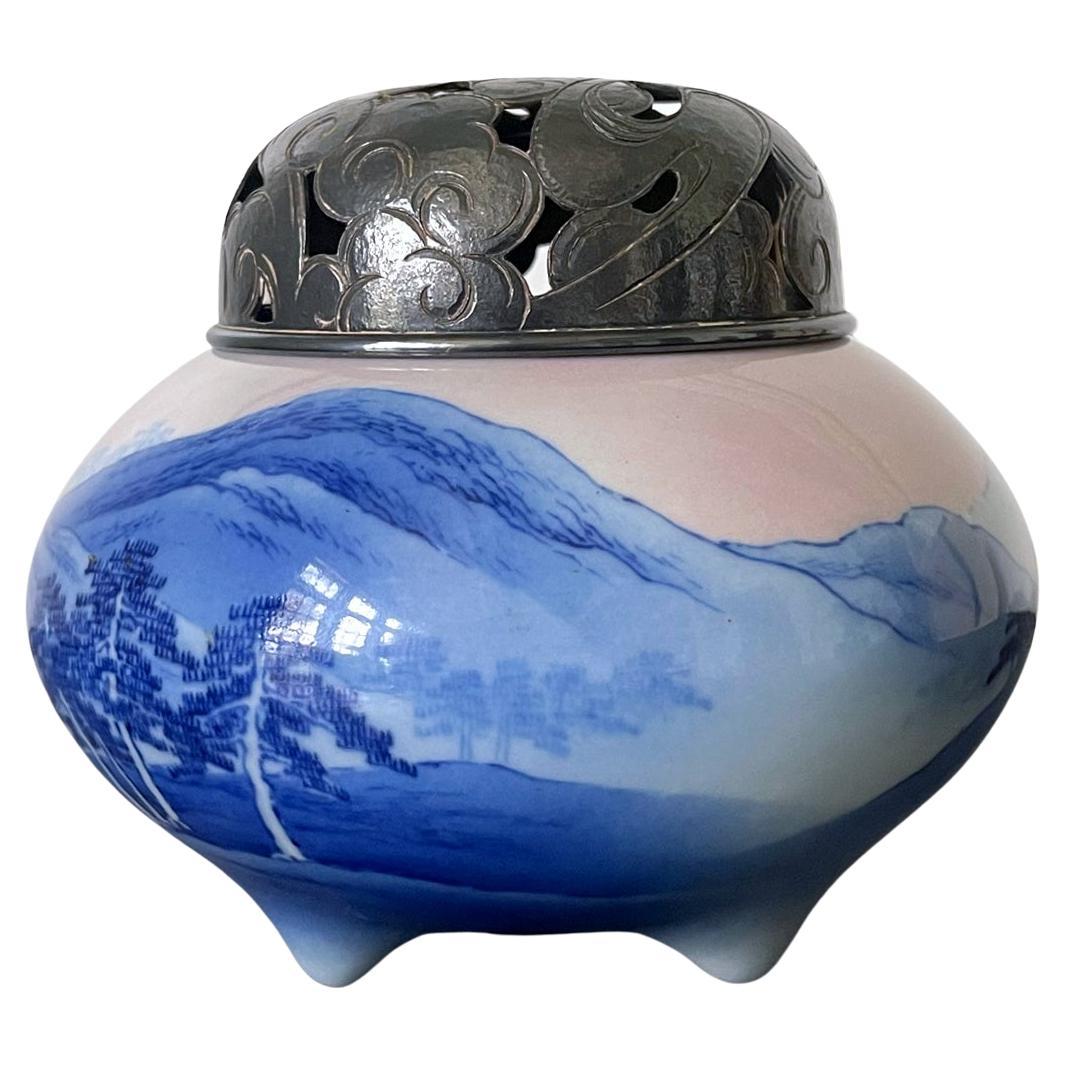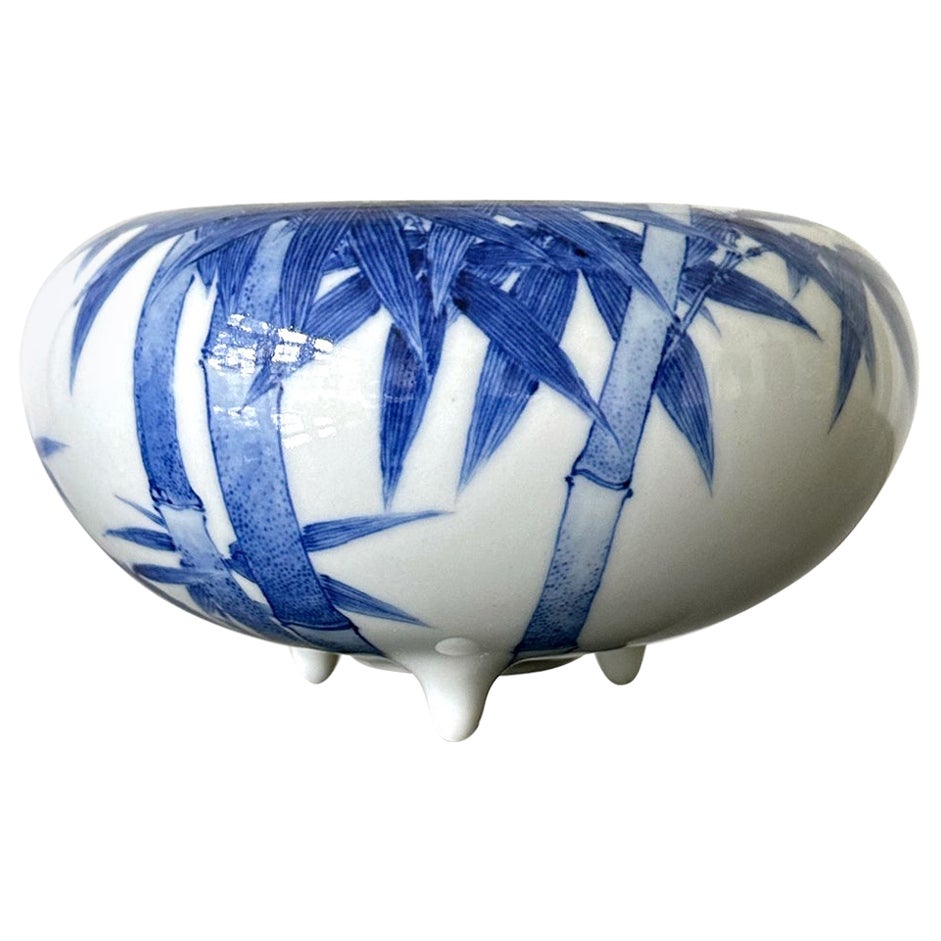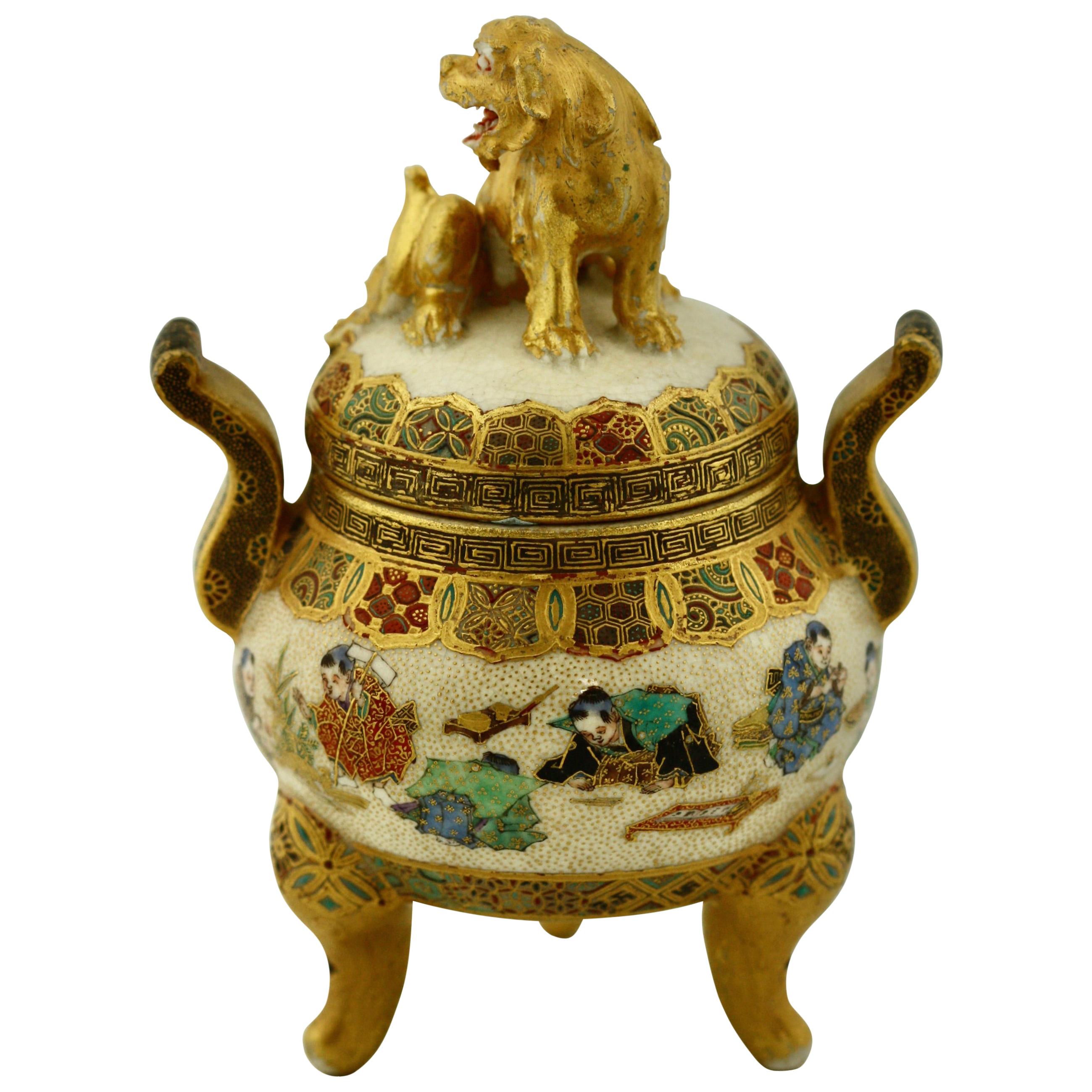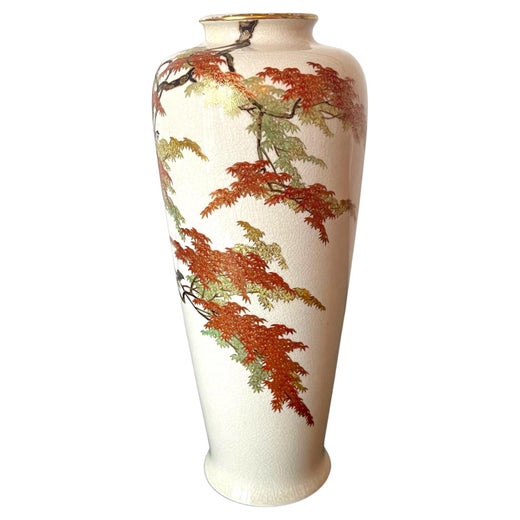Items Similar to Japanese Satsuma Ceramic Ewer Yabu Meizan
Want more images or videos?
Request additional images or videos from the seller
1 of 19
Japanese Satsuma Ceramic Ewer Yabu Meizan
About the Item
A Satsuma ware miniature ewer from the studio of Yabu Meizan (birth name Yabu Masashichi; 1853-1934), who was one of the most celebrated and collectible Satsuma artists from the Meiji Period. From his studio in Osaka, Yabu Meizan oversaw the production of the finest Satsuma wares for both domestic and export markets. He participated many international expose at the turn of the 20th century and won numerous awards for his creation.
This ewer is exquisite in every aspect. The classic elegant form is delicate and harmonious in proportion. The surface was decorated in a dense millefleur pattern (thousand flowers). The detailed rendering is visually stunning. The intricate gold gilt outlining every single petals and then layering them make the piece a piece of miniature art with jewel quality, Scrolling vine design with astonishing details crawls along the handle and pouring neck. The lid is a beautiful carved piece with lotus petals (likely original but it is also possibly a historical replacement). Around the base rim, a geometrical border with double black square features a black enamel background, another signature feature among the his work. The base is marked with the golden seal of Yabu Meizan. Circa early 20th century.
Ewer form is not a common form in Yabu Meizan's repertoire. Millefleur patter was used in some of his work, but generally as a partial element. A full surface covering found on this piece is also relatively rare. Standing 4.75 inches high, the ewer makes a great example of his finest studio work at the pinnacle of the Satsuma ceramic production.
- Creator:Yabu Meizan (Maker)
- Dimensions:Height: 4.75 in (12.07 cm)Width: 4 in (10.16 cm)Depth: 2.2 in (5.59 cm)
- Style:Japonisme (Of the Period)
- Materials and Techniques:
- Place of Origin:
- Period:
- Date of Manufacture:Early 20th Century
- Condition:Wear consistent with age and use. Fine condition nearly impeccable, one tiny bite on the mouth rim as shown, a couple of unevenness along the inner edge of the mouth rim. Contact wear on the base.
- Seller Location:Atlanta, GA
- Reference Number:1stDibs: LU945023732912
Yabu Meizan
Yabu Meizan was a Japanese artist and workshop owner known for painting on porcelain. He was the most prolific producer of Satsuma ware. Meizan actively marketed his work internationally as well as domestically, taking an active role in organizing the presentation of Japanese wares at the world's fairs.
About the Seller
5.0
Platinum Seller
These expertly vetted sellers are 1stDibs' most experienced sellers and are rated highest by our customers.
Established in 2006
1stDibs seller since 2010
479 sales on 1stDibs
Typical response time: <1 hour
- ShippingRetrieving quote...Ships From: Atlanta, GA
- Return PolicyA return for this item may be initiated within 2 days of delivery.
More From This SellerView All
- Japanese Satsuma Vase Yabu Meizan MeijiBy Yabu MeizanLocated in Atlanta, GAA Satsuma baluster form vase from the studio of Yabu Meizan (birth name Yabu Masashichi; 1853-1934), who is one of the most celebrated and collectible Satsuma artists from Meiji Peri...Category
Early 20th Century Japanese Meiji Ceramics
MaterialsCeramic
- Japanese Miniature Satsuma Vase Yabu Meizan MeijiBy Yabu MeizanLocated in Atlanta, GAA small Satsuma vase from the studio of Yabu Meizan (birth name Yabu Masashichi; 1853-1934), who is one of the most celebrated and collectible Satsu...Category
Antique Early 1900s Japanese Meiji Ceramics
MaterialsCeramic
- Japanese Glazed Ceramic and Silver Koro Incense Burner Makuzu KozanBy Makuzu KozanLocated in Atlanta, GAA tri-pod ceramic incense burner (koro) by Japanese Imperial potter Makuzu Kozan (1842-1916) circa late Meiji to the start of Taisho period (1890-1910s). A fine example of the artist's work belonging to the late part of his underglaze paint phase (started around 1887 until his death), the surface of the koro was painted in beautiful shades of blue to depict a continuous landscape not unlike a traditional ink and watercolor hand scroll. The rise and fall mountains recede and fade into the horizon and are dotted with groves of pines. The sky is painted with a beautiful subtle shade of pink, suggesting a time of sunrise or sunset. The koro is fitted with an ensuite reticulated sterling silver hoya (incense cover), pierced with swirling cloud and marked with "pure silver' in Kanji. The base is signed in underglaze blue "Makuzu Kozan Sei" within a double ring. The piece is beautifully potted in form and the decoration was done with expertise using the novel technique developed by Kozan called Fuki-e (the blow painting), in order to achieve the striking landscape known as "Mountain and Water" with sense of dimensions and gradient, the poetic effects normally conveyed only by sumi ink staining on paper. The piece comes with an unsigned tomobako (wood storage box) of a recent age. Also known as Miyagawa Kozan (1842–1916), Makuzu Kozan was one of the most established and collected ceramist from Meiji Period. Born as Miyagawa Toranosuke, Kozan established his pottery studio in Yokohama around 1870s and later became one of the appointed artists to the Japanese Imperial household. His work was exhibited in many international fairs that the Meiji government participated at the turn of the century and won many grand prizes. Being one of the most creative ceramists, Kozan started experimenting with new chemical colors from the West in the format of his porcelain glaze around 1880s. New colors allowed him to create underglaze designs that appeared bright, smooth and glossy. He even invented his own receipt of cobalt blue to achieve a much brighter yet softer shade, as evident on this vase. To create landscape that is realistic and dimensional, more common in the western paintings, he was inspired by the native Japanese ink painting technique developed around 1900 by Yokoyama...Category
Antique Early 1900s Japanese Japonisme Ceramics
MaterialsSilver
- Japanese Glazed Ceramic Bowl by Makuzu KozanBy Makuzu KozanLocated in Atlanta, GATri-pod ceramic bowl likely used as an incense burner (koro) by Japanese Imperial potter Makuzu Kozan (1842-1916) circa late Meiji period. The signature indicates that it was produce...Category
Antique 1880s Japanese Meiji Ceramics
MaterialsCeramic
- Japanese Kyoto Ware Vase Attributed to NinseiLocated in Atlanta, GAAn elegant vase made in Kyoto, Japan, circa 1920s. With a graceful elongated Mei-Ping form, it was likely used as a flower holder during the tea ceremony. The stoneware body has an incised and raised design of Irises in an over glazed indigo blue, an subject matter and composition found in the contemporary paintings and screens, cherished by the literati of the Kyoto society. The vase has a white glazed background sprinkled with dust for a rustic effect. The blue glaze displays some burst of bubbles upon close inspection, suggesting its age. Under the base, there is a small impressed mark of Ninsei (born Nonomura Seisuke) a famous potter from the 17th century, who was considered the founder the Kyoto ware...Category
Vintage 1920s Japanese Japonisme Ceramics
MaterialsCeramic
- Antique Japanese Shino Ware Chawan Tea BowlLocated in Atlanta, GAOn offer is a Japanese ceramic tea bowl (chawan) used in the traditional chado ceremony. The bowl was potted in clog form with a ring foot shaved extremely low. Its size and harmonious proportion make it perfect to be held in both hands during chado. Classified as shino ware...Category
Antique 18th Century Japanese Edo Ceramics
MaterialsCeramic
You May Also Like
- Satsuma Koro and Cover by Yabu MeizanBy Yabu MeizanLocated in West Palm Beach, FLA Satsuma Koro and cover by Yabu Meizan, Osaka, 1853-1934, delicately painted with various scenes of children playing, the top with lion finial, raised on...Category
Antique Early 1900s More Asian Art, Objects and Furniture
MaterialsCeramic
- Japanese Kutani Treasure Boat 'Takarabune' Censer, Taisho Period, JapanLocated in Austin, TXA wonderful Japanese Kutani porcelain incense burner, koro, in the form of a treasure ship, Takarabune, Taisho Period (1912 - 1926), Japan. The censer boldly modeled as the legendary Takarabune, or Treasure Ship, a mythical ship said to carry the shichifukujin, the Seven Lucky Gods, around the heavens during the first days of the New Year, visiting lucky humans to bring blessings and prosperity. The black bodied, single mast ship sails on the water, its sail full of wind and decorated with the character "takara", meaning treasure. The pierced top of the ship serving as the cover for the censer. It is loaded with magical items and treasure, most prominently, a large coral branch...Category
Vintage 1910s Ceramics
MaterialsPorcelain
- A Japanese Satsuma ceramic lobed bowlLocated in Milano, ITSatsuma ceramic lobed bowl with curved corners and embellished with a refined scene of daily life along a watercourse on the outside. The interior is adorne...Category
Antique Late 19th Century Japanese Japonisme Ceramics
MaterialsCeramic
- Satsuma Tapering Cylindrical Square High-Shouldered Vase by Yabu MeizanBy Yabu MeizanLocated in West Palm Beach, FLA Satsuma tapering cylindrical square high-shouldered vase by Yabu Meizan, Osaka, 1853-1934, decorated in polychrome enamels and gilt over a clear, cr...Category
Antique 1850s Vases
MaterialsEnamel
- Koro Satsuma Japanese ceramicLocated in Buenos Aires, ArgentinaKoro Satsuma Japanese ceramic Japanese glazed ceramic in various colors Meiji Style Circa 1940 Origin Japan It has traditional images painted on its front and back. The purpose of th...Category
Vintage 1940s Japanese Meiji Ceramics
MaterialsEnamel
- Japanese Tea Bowl Flying Bats & Good Fortune Hand-Built Hand GlazedLocated in South Burlington, VTMint condition From Japan, a hard to find and unusual hand-built, painted and glazed tea bowl featuring "flying bats" - signs of good fortune, created over thirty years ago. A stunn...Category
Late 20th Century Japanese Showa Ceramics
MaterialsCeramic, Pottery






